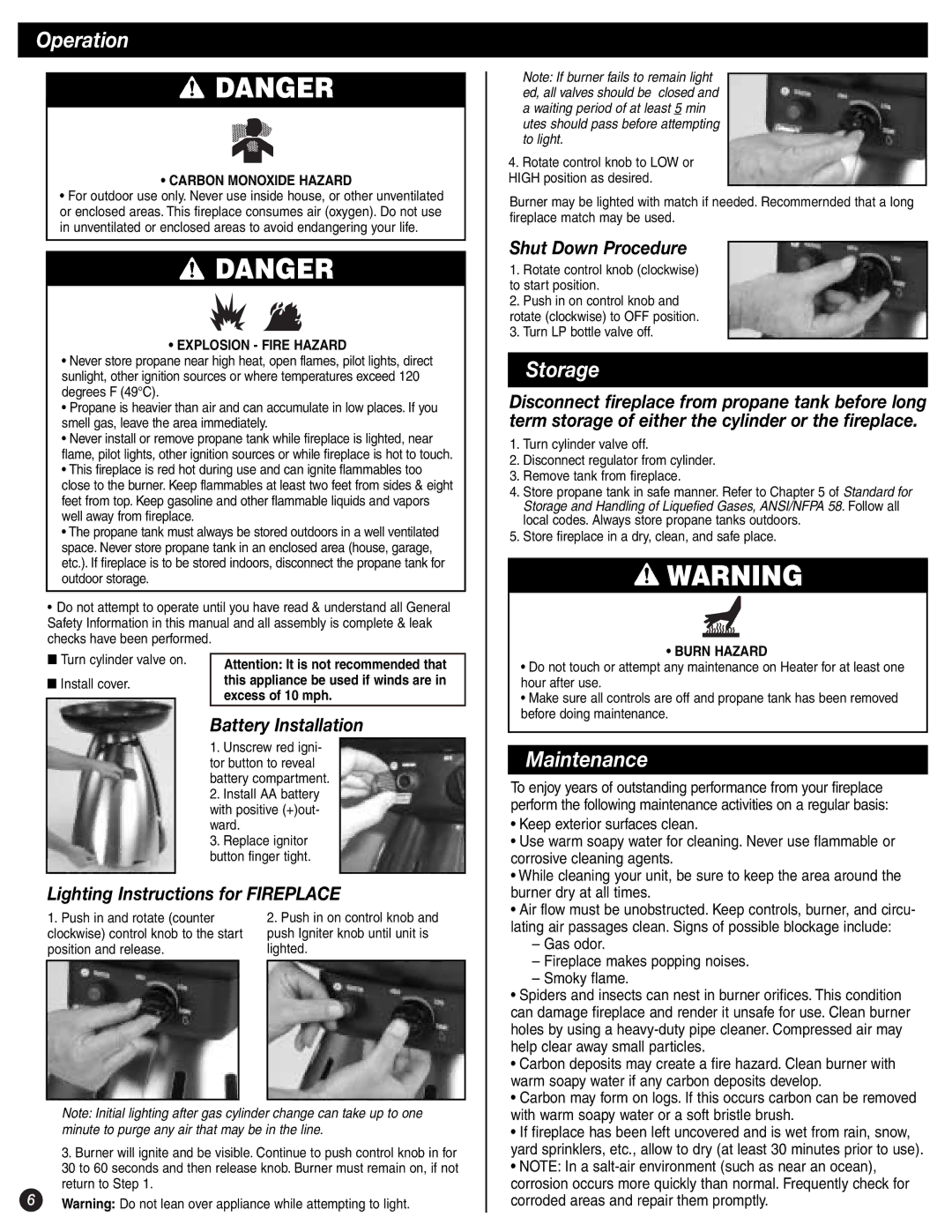
Operation
![]() DANGER
DANGER
•CARBON MONOXIDE HAZARD
•For outdoor use only. Never use inside house, or other unventilated or enclosed areas. This fireplace consumes air (oxygen). Do not use in unventilated or enclosed areas to avoid endangering your life.
![]() DANGER
DANGER
•EXPLOSION - FIRE HAZARD
•Never store propane near high heat, open flames, pilot lights, direct sunlight, other ignition sources or where temperatures exceed 120 degrees F (49°C).
•Propane is heavier than air and can accumulate in low places. If you smell gas, leave the area immediately.
•Never install or remove propane tank while fireplace is lighted, near flame, pilot lights, other ignition sources or while fireplace is hot to touch.
•This fireplace is red hot during use and can ignite flammables too close to the burner. Keep flammables at least two feet from sides & eight feet from top. Keep gasoline and other flammable liquids and vapors well away from fireplace.
•The propane tank must always be stored outdoors in a well ventilated space. Never store propane tank in an enclosed area (house, garage, etc.). If fireplace is to be stored indoors, disconnect the propane tank for outdoor storage.
•Do not attempt to operate until you have read & understand all General Safety Information in this manual and all assembly is complete & leak checks have been performed.
Note: If burner fails to remain light ed, all valves should be closed and a waiting period of at least 5 min utes should pass before attempting to light.
4.Rotate control knob to LOW or HIGH position as desired.
Burner may be lighted with match if needed. Recommernded that a long fireplace match may be used.
Shut Down Procedure
1.Rotate control knob (clockwise) to start position.
2.Push in on control knob and rotate (clockwise) to OFF position.
3.Turn LP bottle valve off.
Storage
Disconnect fireplace from propane tank before long term storage of either the cylinder or the fireplace.
1.Turn cylinder valve off.
2.Disconnect regulator from cylinder.
3.Remove tank from fireplace.
4.Store propane tank in safe manner. Refer to Chapter 5 of Standard for Storage and Handling of Liquefied Gases, ANSI/NFPA 58. Follow all local codes. Always store propane tanks outdoors.
5.Store fireplace in a dry, clean, and safe place.
![]() WARNING
WARNING
■Turn cylinder valve on.
■Install cover.
Attention: It is not recommended that this appliance be used if winds are in excess of 10 mph.
Battery Installation
1.Unscrew red igni- tor button to reveal battery compartment.
2.Install AA battery with positive (+)out- ward.
3.Replace ignitor button finger tight.
•BURN HAZARD
•Do not touch or attempt any maintenance on Heater for at least one hour after use.
•Make sure all controls are off and propane tank has been removed before doing maintenance.
Maintenance
To enjoy years of outstanding performance from your fireplace perform the following maintenance activities on a regular basis:
• Keep exterior surfaces clean. |
• Use warm soapy water for cleaning. Never use flammable or |
corrosive cleaning agents. |
• While cleaning your unit, be sure to keep the area around the |
Lighting Instructions for FIREPLACE
1. Push in and rotate (counter | 2. Push in on control knob and | |
clockwise) control knob to the start | push Igniter knob until unit is | |
position and release. | lighted. | |
|
|
|
|
|
|
Note: Initial lighting after gas cylinder change can take up to one minute to purge any air that may be in the line.
3.Burner will ignite and be visible. Continue to push control knob in for
30to 60 seconds and then release knob. Burner must remain on, if not return to Step 1.
6Warning: Do not lean over appliance while attempting to light.
burner dry at all times. |
• Air flow must be unobstructed. Keep controls, burner, and circu- |
lating air passages clean. Signs of possible blockage include: |
– Gas odor. |
– Fireplace makes popping noises. |
– Smoky flame. |
• Spiders and insects can nest in burner orifices. This condition |
can damage fireplace and render it unsafe for use. Clean burner |
holes by using a |
help clear away small particles. |
• Carbon deposits may create a fire hazard. Clean burner with |
warm soapy water if any carbon deposits develop. |
• Carbon may form on logs. If this occurs carbon can be removed |
with warm soapy water or a soft bristle brush. |
• If fireplace has been left uncovered and is wet from rain, snow, |
yard sprinklers, etc., allow to dry (at least 30 minutes prior to use). |
• NOTE: In a |
corrosion occurs more quickly than normal. Frequently check for |
corroded areas and repair them promptly. |
